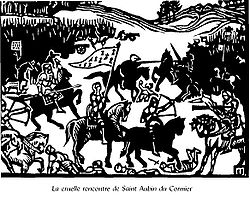Battle of Saint-Aubin-du-Cormier (1488)
| Battle of Saint-Aubin-du-Cormier | |||||||
|---|---|---|---|---|---|---|---|
| Part of the Mad War | |||||||
 The Battle of Saint-Aubin-Du-Cormier as imagined by Jeanne Malivel in 1922. |
|||||||
|
|||||||
| Belligerents | |||||||
|
|
|
||||||
| Commanders and leaders | |||||||
|
|
|
||||||
| Strength | |||||||
| 15,000. | 11,500 | ||||||
| Casualties and losses | |||||||
| 1500 | Around 5,000 - 6,000 | ||||||
The Battle of Saint-Aubin-du-Cormier took place on 28 July 1488, between the forces of king Charles VIII of France, and those of Francis II, Duke of Brittany and his allies. The defeat of the latter signalled the end to the "guerre folle" ('Mad war'), a feudal conflict in which French aristocrats revolted against royal power during the regency of Anne de Beaujeu. It also effectively precipitated the end of the independence of Brittany from France.
Brittany, Burgundy and England had been repeatedly allied to resist the expansion of the French state. In the aftermath of the death of Charles the Bold of Burgundy in 1477, the Burgundian threat to French power was all-but eliminated. Brittany became the main base for the feudal aristocrats in the League of the Public Weal, an alliance founded by Charles the Bold to resist the centralisation of power in the king.
By 1488 the regime of Duke Francis had been severely weakened by conflict between his prime-minister Pierre Landais and a group of aristocrats led by the prince of Orange John IV of Chalon-Arlay. Landais was keen to strengthen ties with England. His opponents secured French support for an armed incursion to overthrow and execute Landais in 1485, after which Jean de Rieux became de facto chief minister.
Francis was keen to secure the independence of Brittany and to construct a network of alliances to achieve that objective, offering the prospect of marriage to his daughter and heir Anne of Brittany to several possible allies. Rebel lords from the League, notably Louis d'Orleans, had sought sanctuary in Brittany. The French saw this as a violation of royal rights, and demanded the return of the lords, asserting that they had the right to take them by force if Francis refused.
Under the leadership of Louis II de la Trémoille, the French royal army had struck against Vannes and Fougères, controlling access to Brittany. The French attempted to take control of the major strategic strongholds.
...
Wikipedia
